![]()
![]()
![]()
Use LEFT and RIGHT arrow keys to navigate between flashcards;
Use UP and DOWN arrow keys to flip the card;
H to show hint;
A reads text to speech;
68 Cards in this Set
- Front
- Back
- 3rd side (hint)
|
What are quantitative traits? |
Not discrete phenotypes (vary continuously) Height, intelligence, measurable attributes Determined by >1 locus |
|
|
|
3 Factors influencing expression of quantitative traits: |
1. Genotype at different loci (G) 2. Environment (E) 3. Combined effect of both (G×E) |
|
|
|
What are the 3 important points in the debate in the study of quantitative genetics? |
1. Many genes each with small effects 2. few genes each with large effects 3. can mendelian genetics be applied to quantitative traits |
Answer: it depends on the trait & the organism |
|
|
Example of mendelian genetics in quantitative traits: |
Longflower tobacco Extreme parent phenotypes: long vs. short If 1 locus, then 3 offspring phenotypes (0.25aa, 0.5Aa, 0.25AA) If 2 loci, 5 phenotypes If 6, 13 phenotypes Actual data: not true breeding (mixed heights), the next generation had middle height distribution, then next gen spread toward extremes When selectively breeding certain heights, they return to minimal variance |
|
|
|
What are QTLs and what is their mapping? |
Quantitative trait loci QTL mapping is a suite of related techniques employing marker loci to scan chromosomes This allows to identify regions on chromosomes that contain loci contributing to a quantitative trait |
|
|
|
Example of QTL mapping: |
Pollination adaptation in monkeyflowers: Some need bees, some evolved for hummingbirds Step 1: Cross 2 species with different pollinators homozygous @ different alleles (though closely related) F1 were all identical heterozygotes F2 showed wide variation/diversity for traits at any given locus (maybe homo or hetero) Step 2: Score using molecular markers @ 66 loci Molecular marker detected with PCR Randomly distributed throughout genomes of 2 parental species Key point: molecular markers have known locations on chromosomes of both parents Step 3: Score individuals for quantitative/phenotypic traits (floral traits associated with pollinator activity) 14 traits in 1,000 plants Step 4: Interpret data Hypothetical: linkage in 2 loci, one is molecular marker and other influences trait Field experiment Findings: bees visited larger flowers with less yellow, hummingbirds visited nectar-rich flowers 1 QTL for yellow pigment reduced bee visits by 80% and 1 for nectar doubled hummingbirds (these 2 alleles are responsible for the differences between the 2 species) |
|
|
|
Phenotype distribution and marker/QTL relationship |
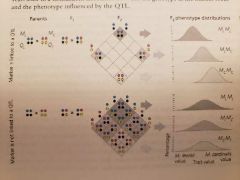
|
|
|
|
Types of variation affecting heritability: |
Phenotypic (Vp) Genetic (Vg) Environmental (Ve) |
|
|
|
Calculating phenotypic variation: |
Genetic (Vg) + Environmental (Ve) |
|
|
|
Broad-sense heritability equation: |
H^2 = Vg/Vp = Vg/(Vg+Ve) |
|
|
|
Parent-offspring heritability plot: |
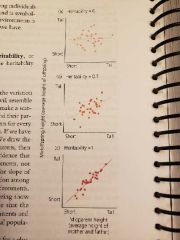
|
|
|
|
Narrow-sense heritability: |
Fraction of phenotypic variation explained by genetic variation Additive variation: Va Dominance variation: Vd Vg = Va+Vd h2= Va/Vp = Va/(Va+Vd+Ve) |
|
|
|
Graphs determining genetic dominance: |
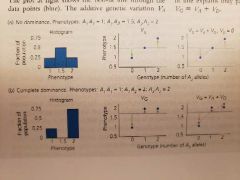
|
|
|
|
Consideration in estimating/calculating heritability: |
What proportion of phenotypic variation is genetic vs. environmental |
|
|
|
Experimental determination of phenotypic variation heritability: |
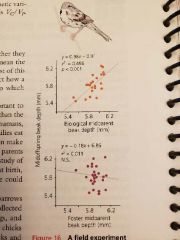
E.g. beak size in song sparrows Collect young from natural nests and transplant in foster parent nest Compare offspring values with parent values both biological and foster Beak size is genetic, not environmental |
|
|
|
Selection and narrow-sense heritability: |
NS heritability can be used to predict population response to selection |
|
|
|
Selection differential / Strength of selection: |
S can measure difference between starting and selected populations' phenotype mean values T - t* = S Whole population - selected population = difference |
|
|
|
Selection gradient: |
Difference between selected and entire population 1. Assign absolute fitness values to all members 2. Convert to relative fitness 3. Plot relative, slope of best fit is selection gradient |
|
|
|
Difference between selection differential and gradient: |

|
|
|
|
Predicting evolutionary response to selection: |
R = h2 × S R: predicted response h2: heritability (genetic capacity to respond) S: selection differential (selection strength/capacity) |
|
|
|
Example of predicting evolutionary response to selection: |
Flower size in alpine skypilot Timberline and tundra populations are different: tundra flowers are larger and only pollinated by bumblebees (need larger platform, is this the selecting factor?) Experiment: only let bees visit timberline flowers, will selection take place within the population? Estimate flower size heritability, parent-offspring regression shows 0.5 broad-sense maternal heritability but narrow-sense says 0.2 (could be 0.2-1.0) Harvest seeds made in controlled environment and measure grown offspring later Results: h2 = 0.2-1.0 S = 0.05 R = 0.01-0.05 Flower size changed 1-5% in a single generation so it could evolve rapidly |
|
|
|
Experiment with how fast pollinator selection takes effect: |
Random hand-pollinating vs. bumblebee choice 9% larger flowers under selection Explains 12% of difference between flower populations |
|
|
|
3 modes of selection: |
Directional - graph line from low to high (mean changes but variance is the same) reduces genetic variation slightly Stabilizing - graph curve selecting for middle (mean is the same but variance decreases) drastically reduces genetic variation Disruptive - graph slight curve peaked at ends selecting for extremes (mean is same but variance increases) maintains genetic variation |
|
|
|
What is an adaptation? |
A trait or characteristic that increases an organism's fitness relative to those without the trait (these traits are adaptive) |
|
|
|
Example of active modern adaptation in the natural world: |
Peppered moths have dark and light forms depending on environment background (genetic but selected for within population) Industrial melanism: industrial soot darkens trees Moth populations shifted from light to dark forms With pollution control, the forms are shifting back to lighter color |
|
|
|
How to demonstrate whether a trait is an adaptation: |
1. Determine what the trait is for (form and function) within the specific environment 2. Determine effect of trait (do individuals with the trait have selective advantage/higher fitness) 3. Test hypotheses |
|
|
|
Example of testing adaptation hypothesis: |
The long neck of the giraffe Hypothesis: giraffes have long necks to access food in taller trees Measure animal height vs. feeding height percentage No significant difference between average feeding height of taller and shorter giraffes Alternative hypothesis: males use necks to fight so females select for longer, larger necks (higher reproductive success, increased fitness) |
|
|
|
What is preadaptation? |
A trait selected for in one environment that serves a new function in another |
|
|
|
3 ways to test for adaptations: |
1. Experiments 2. Observational study 3. Comparative method |
|
|
|
3 Considerations when studying adaptations: |
1. Differences among populations and species are not always adaptive 2. Not every trait or its use in an organism are adaptations 3. Not every adaptation is perfect |
|
|
|
Components of good experimental design: |
Control groups Treatment groups Replication (larger sample size ideal, accounts for variability in experiments) Randomization |
|
|
|
Example of experiment for adaptation determination: |
Wing markings and waving in tephritid fly Hypothesis 1: they are not mimicking jumping spiders 2: they are mimicking jumping spiders to deter other non-spider predators 3: they are mimicking the spiders to deter their predation Treatment: normal tephritid, teph. with wings cut and glued back on, teph. with housefly wings, housefly with teph. wings, and normal housefly Starve jumping spiders and other predators then expose them to different fly treatments Results: other predators attacked everything, but jumping spiders retreated from teph. flies with their own wings Hypothesis 3 appears to be correct |
|
|
|
Example of comparative method for adaptation determination: |
Testes size in Megachiroptera If sperm competition takes place, then species that roost in larger groups would have larger testes Measured data from flying foxes showed a strong correlation between those two variables When compared to multiple species that all shared a common ancestor, there was also a significant positive correlation among the contrasts Conclusion: species that evolved larger roosting group sizes also evolved larger testes size for body size to adapt to sperm competition |
|
|
|
Example of observational studies for adaptation determination: |
Garter snakes at Eagle Lake, CA Hypothesis: thermoregulation by ectotherms is adaptive Need to 1. demonstrate whether choice of temperature is adaptive because 2. if a choice is not random, ectotherms are actively engaging in thermoregulation Data: in the lab, the snakes preferred temps between 28-32° C Radio transmitters implanted in snakes beep corresponding to temp Real snakes moved from rock to sunlight or stayed under a very particular rock all day to keep temp between the prefered range measured in the lab Team used "model" snakes in the same places the real snakes were and temperatures ranged wildly meaning the real snakes are actively thermoregulating Snakes show distinct preference for medium rocks with best temperature regulation throughout the day |
|
|
|
Discuss the question: what is a species? |
Biologists agree species is the smallest evolutionarily independent unit with their own trajectory Challenge of establishing practical criteria for identifying independent evolution of populations First approximation: species are isolated due to lack of gene flow between, become reproductively isolated |
|
|
|
4 Species concepts: |
Morphospecies concept Phylogenetic species concept Biological species concept Evolutionary species concept |
|
|
|
Morphospecies concept: |
Extant species defined by phenotypic differences Used for both sexual and asexual species Fossil species have been defined by morphological differences Not done carefully, species definitions can become arbitrary, idiosyncratic, or not comparable Does not work for cryptic species which look similar but are different |
|
|
|
Phylogenetic species concept (who? What does it mean?): |
Developed by Cracraft in 1983 Groups of organisms that share at least one unique synapomorphy Also called genealogical species concept Groups of organisms that have a more recent common ancestor than any other group Monophyletic groups = clades Data from cladistic analysis is resolving species boundaries Would increase number of recognized species |
|
|
|
Biological species concept (who? Problems?): |
Ernst Mayr 1942 Groups of individuals that reproduce amongst themselves but are reproductively isolated from other groups Has a genetic basis - gene flow occurs between members of same species but not others Species do not hybridize (offspring not fertile), plants are a problem here Requires educated assumptions to determine Problems: what about disjunct populations? What about asexual organisms? What about fossil forms? |
|
|
|
Evolutionary species concept (who? What for?): |
Wiley 1978 A lineage evolving independently from other lineages with it's own evolutionary trends and tendencies Based on the products of evolution, species should have same evolutionary history and future Used to identify Evolutionarily Significant Units in conservation biology |
|
|
|
3 step process of speciation |
The process is a continuum 1. Physical (geographic) isolation leads to genetic isolation 2. Genetic divergence 3. Reproductive isolation |
|
|
|
Mechanisms of physical (geographic) isolation: |
Allopatric speciation 1. Dispersal and colonization: entrance to new habitat, founder hypothesis 2. Vicariance: existing range is split by new physical barrier |
|
|
|
Allopatric speciation: |
Mayr 1942 Speciation by populations that are physically isolated from each other Isolation usually means smaller population sizes leading to genetic isolation Prevents gene flow so populations can evolve and diverge independently of each other Can occur on a microgeographic scale: short dispersal distances or strict environmental ties may allow speciation to occur over short distances |
|
|
|
Example of dispersal and colonization: |
Fruit flies on Hawaiian islands The flies found on the islands diverged along the same time scales as the creation of the islands they live on They moved to a new island and adapted to it and, without connection to the original population, became a new species |
|
|
|
Example of vicariance: |
Snapping shrimp and the Isthmus of Panama When the isthmus of Panama closed, the marine species on each side were closed off for interbreeding and became their own species |
|
|
|
Peripatric speciation: |
When colony derived from widespread species diverges on the periphery/edge of the species range Populations on the edge are small so genetic diversity is more substantial; they are also in changing habitat so changing pressures Very rare (some kingfisher birds in New Guinea may be speciating around edges of species habitat) |
|
|
|
Sympatric speciation: |
Speciation within the same habitat without dispersal or barriers Relies largely on polyploidy (increase in the number of entire sets of chromosomes) very common in plants with unreduced gametes Old and new populations immediately experience reproductive isolation (diploid + tetraploid = triploid, cannot reproduce) Important speciation process in plants (50-80% of all plants this way) |
|
|
|
Example of polyploidy in speciation: |
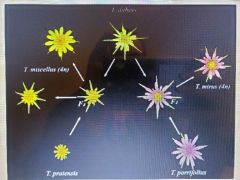
Tragopogon species 3 diploid species (n=7) native to Eurasia and introduced in the Palouse region in early 20th century Diploid hybrids are weakly fertile due to incomplete segregation at meiosis All have different flowers 2 hybrids have chromosome doubling (tetraploidy n=14, 4 entire chromosome sets) now completely fertile |
|
|
|
Mechanisms of genetic divergence: |
1. Genetic drift 2. Adaptation to different habitats 3. Assortative mating |
|
|
|
Genetic drift and speciation: |
Sampling error during periods of small population size = founder effects/population bottlenecks Recent introductions and invasions Small populations may undergo rapid genetic divergence, controversial topic because support for speciation by drift is lacking (selection is probably more important) |
|
|
|
Adaptation to different habitats: |
Genetic divergence may occur with movement into new habitat/resource = different selection pressures |
|
|
|
Example of habitat-specific life history adaptation: |
Yellow monkeyflower Native to western north America Two distinct "ecotypes": coastal (perennial) and inland (annual) They're still the same species, can hybridize, just different life history |
|
|
|
Assortative mating and speciation: |
Differences among mating behavior of populations Changes in how sexual organisms choose mates can lead to rapid divergence among populations Promotes divergence because it affects gene flow directly |
|
|
|
Example of assortative mating: |
Hawaiian crickets: Male song pulse and female response (two different pulse rates) Females respond strongest to the pulse rate of males of their own species |
|
|
|
What is hybridization? |
Secondary contact What happens when recently diverged populations/species come back into contact and potentially interbreed Common in plants but only 10% of all bird species hybridize and produce fertile offspring |
|
|
|
Pre-zygotic isolating mechanisms: |
No fertilization occurs, they have differences in mate choice or timing of breeding Factors like mating calls, dances only work for certain species No hybrid zygotes are formed |
|
|
|
Post-zygotic isolating mechanisms: |
Dysfunctional development or reduced fitness of hybrid Hybrids are formed but do not survive or are sterile E.g. mules (horses and donkeys) can't reproduce |
|
|
|
What is reinforcement? |
If F1 hybrids are less fit than either parent species, they are at heterozygote disadvantage Selection should reduce the frequency of hybrids leading to reproductive isolation A mechanism to prevent hybridization should evolve finalizing the speciation process Would predict that pre-zygotic isolating mechanisms come into play more frequently in sympatric than allopatric populations Not often seen in natural populations |
|
|
|
Hybridization: |
Interbreeding between two recently-diverged populations or species means hybrids form |
|
|
|
Diploid hybrid speciation: |
Formation of a new species by combining genome of 2 other species Only certain combinations of alleles are able to coexist in hybrids |
|
|
|
Hybrid zone: |
Region where interbreeding between species (genetically diverged populations) occurs and hybrid offspring will be found |
|
|
|
Primary hybrid zones: |
Originate through natural selection for certain traits Position of the zone usually corresponds to a sharp change in one or more environmental factors Often occurs at an ecological border |
|
|
|
Secondary hybrid zones: |
Formed when 2 formerly allopatric populations expand so that they meet and interbreed Doesn't need an ecological border Most common type of hybrid zone |
|
|
|
Timescale of life |
Universe began 14 BYA Solar system and Earth 4.5-4.6 BYA Water vapor condenses to ocean 4.5 BYA Oldest rocks 3.8 BYA First life/Precambrian 3.5 BYA Photosynthesis 2.5 BYA Eukaryotes 1.8 BYA Fossils 640 MYA Cambrian explosion 543 MYA Cenozoic 65 MYA |
|
|
|
5 properties of living organisms |
1. Ability to self-replicate (grow and reproduce) 2. Obtain and use energy and material (catalyze reactions) 3. Respond to changing conditions/stimuli 4. Exhibit high levels of diversity 5. Possess DNA = genetic code of all living organisms |
|
|
|
Likely steps in origin of life: |
Production of organic molecules from abiotic chemical reactions RNA catalyzes and self-replicates Lipid membranes form spontaneously for cells Evolution of protein enzymes is greatest unsolved problem |
|
|
|
Theories of where organic molecules for life came from? |
1. Oparin-Haldane model: earth possessed organic molecules for life 2. Null model: extraterrestrial origins (meteorites, cosmic dust) |
|
|
|
Overview of Precambrian: |
Dominated by prokaryotes for 2 billion years, no nucleus or organelles 1.8 BYA stromalite bacteria shows transition to eukaryotes Nucleus and chromosomes, organelles like mitochondria and chloroplasts Endosymbiont hypothesis: mitochondria and chloroplasts are descendants of free-living bacteria captured by pre-eukaryotic cells Multicellular animals around 640 MYA Edicaran fauna: small, simple, soft, no skeleton, crept or stood on sea floor |
|

